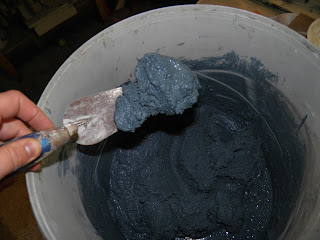Two days a week I shall be working for Mathias Lootvoet (see the last photo). His company build large scale projects from entirely natural building materials. They source their materials as locally as they can to reduce the hidden CO2 of transport and mix many of their own products to reduce commercial processing emissions.
Despite this excellent record, I woke up at 5am yesterday morning full of nerves for my first day at Het Leemniscaat. Saskia knows him really well and spent the last week telling me all his filthy habits and exactly how hard he would be on my first day to see if I was tough enough to earn his respect. I was expecting an ogre. Or at least a bit of a git. Saskia seemed almost more nervous than me; she made me a huge thermos of Wake-Up tea and extra sandwiches because Mathias was likely to steal my food from my bag and I should have some hidden in my trousers or jacket pockets. She dropped me off at his studio at 6.30am and as I got out of the car she handed me a card with her phone number and home address on it so that I could find my way home. I felt like a refugee or a kid on her first day at playschool!
After an hour driving in the dark we arrived in a village the far side of Belgium (Belgium's small!). The site is part of a community living project. 5 families have bought and gutted a huge barn and stables built on a quadrant with an inner courtyard and garden. The existing buildings are made with beautiful red brick and terracotta tiling and to preserve them, completely freestanding timber structures have been constructed inside.
In the house we were working in this week the hempcrete had already been rammed a few weeks earlier and the wooden forms already removed from the walls so we spent the whole first day preparing the walls for the clay with reeds and a natural primer, mixed on site, made of sand, water and plant cellulose. "Natural and delicious like porridge" says Mathias.
The reeds are stapled to the wooden frame and beams so that the clay will have something to adhere to. The primer is only needed on boarded areas such as the shower cubicle, not on the hempcrete. As wood responds to humidity by subtly expanding and contracting, we applied a fibre glass netting over the areas most at risk of movement to reduce cracking in the finish of the clay. Fibre glass isn't 'eco' and Het Leemniscaat is sourcing and trialing netting which works as well from other materials. So far the jute netting products have all been rejected as it gets heavy and waterlogged too easily and begins to sag down, warping the walls before they've dried properly. Flax netting is the team favourite but sourcing it locally-made is proving difficult.

I left the site at 5.30 absolutely shattered and aching all over and I'd only had responsibility for a few rolls of orange tape and an industrial staple gun. By the time I got home I was fit only for a hot bath, a bowl of steamed veg and an early night.
Tuesday morning saw a bright and breezy 6am departure for the site followed by a whole day of clay render shovelling, mixing, spraying and spreading with a brief but welcome stop for cake. One of the team has a weekend job at Julie's House in Gent and brought in several boxes of delicious pie shaped fun for us to scoff. I had a slice of apple tart, half a slice of tiramisu cake and a smidgeon of an incredible meringue and chocolate roulade. I could have managed more but I'm new to the team and I didn't want to come across as greedy..
The mixer can produce 40 litres of sprayable clay at a time and it was going all day long. One man sprayed the walls while the rest of us leapt to comb the clay smoothish, apply the netting and smooth again with serrated edged palate knives. The varying qualities of the palates and Stanley knives soon became obvious and the best ones were covetted fiercely. So much so that I found 3 clay coated Stanley knives in my pockets when I got home. The tools also gave unexpected rise to jokes like 'De tanden op deze kam zijn zo bot en gebroken het doet me denken aan je moeder!'* Apparently 'Yo Mama' jokes are internationally popular, who'd've thought it?

We got absolutely clarted in it, the man with the clay covered specs on is Mathias. My hair is cracking now as I type and I'm too afraid to undo my plait because I'll get clay all over the bathroom. My trousers are standing-up-on-their-own-stiff and soaked and I'm sure will still be extremely uncomfortable tomorrow. My arms ache and I've got cuts all over my hands from the scratchy clay. Bizarrely, I feel more energised than yesterday evening although I am dreading tomorrow's alarm already.
Also, in exciting extra curricular news, one of Mathias's team has invited me to a talk next Tuesday by the Belgian architect Peter Voss in Limburg. Belgium is the European leader for strawbale buildings (I learnt today) and Peter Voss is one of the leading proponents of straw construction. Excited!
*'The teeth on this comb are so blunt and broken it reminds me of your mother!'


















